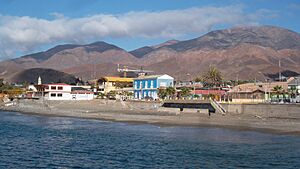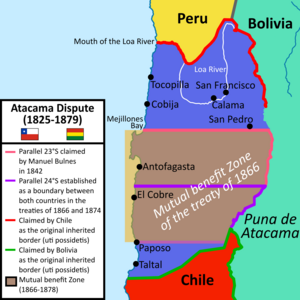Taltal facts for kids
Quick facts for kids
Taltal
|
|||||
|---|---|---|---|---|---|
 |
|||||
|
|||||
| Country | |||||
| Region | |||||
| Province | Antofagasta | ||||
| Established | 12 July 1858 | ||||
| Government | |||||
| • Type | Municipality | ||||
| Area | |||||
| • Total | 20,405.1 km2 (7,878.5 sq mi) | ||||
| Elevation | 2,098 m (6,883 ft) | ||||
| Population
(2012 Census)
|
|||||
| • Total | 11,132 | ||||
| • Density | 0.545550/km2 (1.41297/sq mi) | ||||
| • Urban | 9,564 | ||||
| • Rural | 1,536 | ||||
| Time zone | UTC−4 (CLT) | ||||
| • Summer (DST) | UTC−3 (CLST) | ||||
| Area code(s) | 56 + 55 | ||||
| Website | Municipality of Taltal | ||||
Taltal is a city and a commune (a type of local government area) in Chile. It is located in the Antofagasta Region of Chile. In 2012, about 11,132 people lived there. The area of Taltal is about 20,405 square kilometers.
Taltal is home to the Paranal Observatory, which is a very important place for looking at space. It also includes the northern part of Pan de Azúcar National Park, a beautiful natural area.
Contents
What Does the Name Taltal Mean?
Some people believe the name Taltal comes from the Mapuche language. The word Thalthal in Mapuche means “night bird.” If this is true, it would be one of the most northern places in Chile with a Mapuche name.
A Look Back at Taltal's History

Taltal's story began in 1850 when José Antonio Moreno opened a copper mine called "El Cobre." This mine was about 20 kilometers north of where Taltal is today. Miners and people looking for valuable minerals came to the area. In 1855, Moreno started working in Taltal itself.
More copper was found in 1858 on a nearby mountain called Cachiyuyal. This made the port of Taltal very busy. So, on July 12, 1858, Taltal was officially recognized as a port.
The town really grew starting in 1876. This was because of the discovery of nitrate mines, especially potassium nitrate. Nitrate was used to make fertilizer and explosives. In 1879, the first nitrates were shipped from Taltal. A railway was built in 1882 to connect Taltal to the nitrate mines. This railway was owned by a British company.
At its busiest time in the 1930s, Taltal had over 30,000 people. It was the third largest port in Chile for shipping nitrate. However, nitrate mining eventually ended. The railway was taken apart in 1970.
On June 18, 1991, heavy rain caused mudslides that damaged parts of the city.
How Many People Live in Taltal?
In 2002, a study showed that Taltal had 11,000 people. About 6,182 were men and 4,918 were women. Most people (86%) lived in the city area, while 14% lived in the countryside. Between 1992 and 2002, the population grew by a small amount, about 2.3%.
How Taltal is Governed
Taltal is a commune, which is like a local district. It is managed by a group called a municipal council. The leader of the council is called an alcalde (mayor). The mayor is chosen by the people in an election every four years. The mayor from 2008 to 2012 was Guillermo Hidalgo Ocampo.
Fun Things to See and Do in Taltal
Taltal and the areas around it have many interesting places to visit:
- Llullaillaco National Park: This huge park covers about 268,670 hectares. It is high up in the Andes mountains, between 3,000 and 6,700 meters above sea level. It includes the Llullaillaco Volcano, which is 6,739 meters tall! The park is home to wild animals like vicuñas and guanacos. It is a dry, mountainous area with salt flats.
- Paranal Observatory: This famous observatory is located on Cerro Paranal in the Atacama Desert. It is about 110 kilometers north of Taltal. The European Southern Observatory runs it. Soon, an even bigger telescope called the E-ELT (European Extremely Large Telescope) will be built nearby on Cerro Armazones.
- Cifuncho Bay: About 30 kilometers south of Taltal, you'll find Cifuncho bay. It has a long, beautiful beach with white sand and clear blue water. Many people think it is one of the most beautiful beaches in Chile.
- El Medano Canyon: This canyon is about 90 kilometers north of Taltal. It is a very important place to see cave paintings. These paintings were made by an old culture called the Chango people. They show scenes of hunting guanacos, sea lions, and whales. Experts believe these paintings are between 500 and 1,000 years old.
- Caleta Paposo: This small bay is 54 kilometers north of Taltal. It used to be a mining center. The ancient Chango people also lived here. The area around Paposo is green because of moisture from the sea. It has many different plants and animals. In the 1800s, this area was a border between Chile and Bolivia.
Old Buildings and History
The city of Taltal has many old houses and buildings that are part of Chile's cultural history. Some important ones include:
- The Alhambra Theatre (built in 1921)
- The Augusto Capdeville Museum (built in 1885)
- Old railroad houses (built in 1886)
- The Plaza Hotel (built in 1898)
- The Protestant church (built in 1896)
Taltal Wind Farm
A company called Enel Green Power has started building a new wind farm in Taltal. A wind farm uses large windmills to create electricity from the wind. This project will cost about 190 million US dollars. It will have 33 windmills and produce 99 megawatts of power. This will make it the biggest wind farm in Chile!
Taltal's Weather
| Climate data for Refresco, elevation 1,850 m (6,070 ft) | |||||||||||||
|---|---|---|---|---|---|---|---|---|---|---|---|---|---|
| Month | Jan | Feb | Mar | Apr | May | Jun | Jul | Aug | Sep | Oct | Nov | Dec | Year |
| Mean daily maximum °C (°F) | 27.4 (81.3) |
27.5 (81.5) |
27.7 (81.9) |
27.2 (81.0) |
25.1 (77.2) |
23.3 (73.9) |
23.7 (74.7) |
24.8 (76.6) |
26.8 (80.2) |
26.9 (80.4) |
27.6 (81.7) |
27.5 (81.5) |
26.3 (79.3) |
| Daily mean °C (°F) | 17.5 (63.5) |
17.2 (63.0) |
16.3 (61.3) |
14.7 (58.5) |
12.9 (55.2) |
10.8 (51.4) |
11.1 (52.0) |
12.0 (53.6) |
13.4 (56.1) |
14.6 (58.3) |
16.2 (61.2) |
16.0 (60.8) |
14.4 (57.9) |
| Mean daily minimum °C (°F) | 7.3 (45.1) |
7.1 (44.8) |
7.3 (45.1) |
7.0 (44.6) |
5.4 (41.7) |
4.1 (39.4) |
4.3 (39.7) |
4.7 (40.5) |
5.3 (41.5) |
6.0 (42.8) |
6.5 (43.7) |
7.0 (44.6) |
6.0 (42.8) |
| Average precipitation mm (inches) | 0.0 (0.0) |
0.3 (0.01) |
0.2 (0.01) |
0.0 (0.0) |
1.7 (0.07) |
1.7 (0.07) |
4.4 (0.17) |
0.2 (0.01) |
0.0 (0.0) |
0.7 (0.03) |
0.0 (0.0) |
0.0 (0.0) |
9.2 (0.37) |
| Average relative humidity (%) | 54 | 55 | 53 | 50 | 48 | 48 | 46 | 48 | 45 | 44 | 44 | 45 | 48 |
| Source: Bioclimatografia de Chile | |||||||||||||
See also
 In Spanish: Taltal para niños
In Spanish: Taltal para niños




